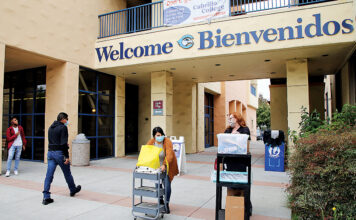The word “whisky” comes from Scottish and Irish Gaelic, “uisge beatha,” or “usquebaugh,” meaning “water of life.” Many other countries give the same name to their distilled spirits including “eau de vie” in France, “acquavite” in Italy, and “akvavit” in Scandinavia. Why would anyone want to take away something as essential as the “water of life”?
Unfortunately, working men sometimes had the habit of spending their wages on imbibing too much of this precious water and not bringing any money home to their wives and children. Obviously, this was not a well thought out strategy by the men.
In the 1800s, temperance movements were formed to ban alcohol and to improve public morals. Eventually, they were successful at creating prohibition in the United States. The act was passed in January of 1919 and took effect on Jan. 17, 1920, almost 100 years ago.
One Aptos entrepreneur could not even wait for prohibition to pass before he was in trouble over the sale and use of alcohol. Patrick Walsh, an immigrant from Ireland, had purchased the land on the bayside of Soquel Drive and Trout Gulch Road in 1865. He built a home and the first full service hotel in Aptos. The hotel was called Live Oak House and it contained a saloon and card room which became very popular with the locals and travelers alike.
Before prohibition, the California legislature had passed a local option law in 1911 which allowed local jurisdictions to decide whether or not to prohibit the sale of alcoholic beverages. The Aptos District voted itself “dry” in November of 1912. After 50 years in business, Walsh was not about to close his saloon. He was warned, and then arrested, but no judge in the Aptos District was willing to find him guilty. Ultimately, the District Attorney brought charges. Walsh was found guilty, and at the age of 83, he was the oldest person in California to face sentencing. He was unwilling to pay the $300 fine, so he was remanded to jail. He was kept in an unlocked cell where he played cards with his friends and drank whisky, since alcohol was still legal in Santa Cruz.
The National Prohibition Act prohibited the production, sale, and transport of intoxicating liquors. Human nature being what it is, people who had never consumed alcohol suddenly wanted it. Oddly enough, Scotch could still be legally imported into the United States by six Scottish distilleries because it could be considered a medicine with a doctor’s prescription. Each ill person was permitted one pint every 10 days.
Surprisingly, the demand for medicinal Scotch went through the roof and the six distilleries could not keep up, so both legitimate and illegitimate Scotch from other producers was shipped to Canada and the West Indies which were close enough to the United States for it to be smuggled in.
Fake and watered down whiskys were rampant, so Cutty Sark, a new, lighter brand of blended Scotch, was created exclusively for export. It was shipped to the Bahamas for the American market by a Captain McCoy. His reputation for bringing real Scotch whisky led to the expression, “It’s the real McCoy.”
Rio Del Mar was a main entry point for booze from Canada. Monterey was too rocky. When the moon and tides were right, ships and boats would sail into shallow water anywhere from New Brighton to La Selva Beach. A small boat would bring a line from the main ship to the beach and the sacks of Scotch would slide down the line to the beach where they would be packed onto trucks. Locals would sometimes show up to help unload the whisky. They would be paid $20 for a couple hours of work and maybe get a couple bottles of Scotch. The trucks would go to storage places in La Selva Beach or up Trout Gulch or Valencia Roads. One of the storage places was Johnnie Ross’s Ranch at 1051 Valencia Road. Johnnie Ross was the builder and caretaker of the Forest Glen subdivision. When the Sheriff would raid places like these, they would take the liquor to a garage at the county corporation yard where it gradually disappeared. In 1924, more than 100 sacks of illicit Scotch whiskey (worth $45,000) were seized at Aptos Beach. Alcohol distributed from our beaches was believed to have supplied much of Northern California. Based on the money to be made, there was a certain amount of local graft and corruption during this period. The liquor profits helped to finance organized crime and bootleggers carried guns, including machine guns.
In Seacliff, the bootlegger ships would unload the Scotch right onto the Concrete ship. Party goers would also bring their own bottles with them to the dances on the Palo Alto, where empty bottles could be discreetly dropped over the side. After the Palo Alto was cracked in 1932, smugglers still found it easier to unload alcohol onto the ship and wheelbarrow it to the trucks instead of using a dinghy. Eventually, a night watchman was hired and scared bootleggers away with the searchlight.
The Rio Del Mar Country Club hotel was just up the road from the landing points and staff could readily pick up their supplies from the beach. The inside and outside walls of the hotel were far enough apart to walk between, so that bootleg liquor could be stored out of sight.
Edward Boyd Stewart was the Secretary of the Rio Del Mar Country Club and lived just up the street at 309 Rio Del Mar Blvd. When his house was remodeled in the 1960s, a hidden compartment was found under the staircase with two cases of premium Scotch whisky left over from prohibition. Eventually, another case of Scotch was found inside the garage wall. The Deer Park Tavern, (now Bittersweet Bistro), was another notorious watering hole. By the end of the “Great War,” (WWI), Americans had developed an interest in Scotch whisky. Prohibition fanned the flames into a full-blown love affair.
Next installment, “bathtub gin.”











